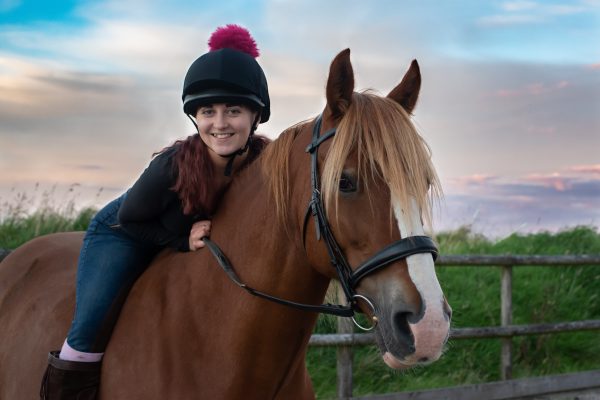
Are you a bit bored with riding round and round in circles? Got the winter blahs? We’ve got an idea that might make your daily ride a bit more exciting: Leave your saddle in the tack room and ride bareback!
Bareback riding can be lots of fun, and sitting right on your horse’s warm back can keep you cozy in the winter—even when it’s pretty cold.
Bareback riding can also help you improve your riding skills because it helps your balance and strengthens your legs. You really have to learn to move with your pony when you ride bareback. It’s easier to stay in sync with him when you don’t have a saddle separating you.
Here are some safety rules to follow when you ride bareback:
Work in a small arena in case your horse is naughty and decides to buck or run off with you. Your horse may never have been ridden bareback and he might find it strange at first.
Wear a helmet—we know you always do, right?
Try to ride a quiet horse. If your horse is hyper, practice riding bareback on a quiet mount before trying it on your horse.
Bony back
If your horse has a nice, wide back, he’ll be quite comfortable to ride. But if he’s a skinny horse or a Thoroughbred with a bony backbone, riding him bareback could be pretty uncomfortable—especially if he has a bumpy trot! If your horse is a bit bony, invest in a bareback pad. This is a fleecy pad (kind of like a saddle pad) that has a girth attached to it. A bareback pad can prevent a sore derriere!
Hop on
If you’re a vaulting champ or a games whiz, you might be able to vault right up on to your horse’s back. But for the rest of us, a mounting block or a leg up is a must! Try to mount your horse quickly and lightly. Don’t slam down on his back and startle him.
Getting used to bareback
Riding bareback can feel a bit strange at first. Stick to the walk until you get used to the feeling. You may not feel as secure as you do when you ride in a saddle. Sit back on both of your seat bones and keep your lower legs close to your horse’s side. You might have to grab hold of mane if you feel insecure, so keep your hands close to your horse’s neck. Follow the movement of his head with your hands. If he acts nervous, stroke him on his neck and talk to him soothingly. He might be wondering, “Where’s the saddle?”
Walk him in some circles and ask him to halt and stand a few times. Make sure you’re totally in control at the walk before you ask your horse to trot or canter.
Faster speeds
Before you ask for the trot, press your seat bones into your horse’s back and try to relax your upper body and arms. Let your legs hang down long. Your thighs and calves should touch your horse’s sides. Don’t grip tightly with your knees when your horse speeds up because this will make you lean too far forward over his neck. If he stops abruptly or bucks, you’ll go flying!
If you bump around too much, lean forward slightly and grab hold of mane.
As you get used to the faster gait, try to sit up tall and absorb your horse’s movement with your body. Try to keep your hands still. Don’t yank your horse in the mouth.
Once you’ve mastered sitting trot, try posting. Stay on the correct diagonal as you trot around the arena. Posting trot is hard work so you probably won’t be able to do it for long.
Cantering
You should find cantering a lot less bumpy than the trot. In fact, it can be downright comfy. Ask for the canter as you would with a saddle. Keep your inside leg near the girth area and nudge your horse with your outside leg behind the girth area. Make sure you are on the correct lead. Stick to a slow canter so you don’t lose your balance.
Jumping bareback
If you feel confident trotting and cantering bareback, you can try a SMALL jump. Only jump bareback if your horse is a well-trained, quiet jumper. As you approach the fence, lean forward slightly and grab hold of some mane to make sure you jump with your pony and don’t get left behind. Getting left behind when you’re jumping bareback can be uncomfortable for both you and your horse and there’s a good chance that you’ll get bounced off and land on the ground. Ouch.
Falling off
Speaking of falling off! If you find yourself slipping off your horse at some point and you can’t wriggle up on to his back again, do an emergency dismount. You’ll have to think quickly though. Grab the reins in one hand (if you can), press your hands on his neck and push up, swing your legs up and over your horse’s hindquarters and leap away from the horse. Try to land facing forwards with both feet on the ground. Bend at the knees to absorb the impact of the fall.
If your horse stops or slows down, hold on to the reins. If he keeps running, let go of them. It’s better to break the reins than to get dragged and break an arm!


